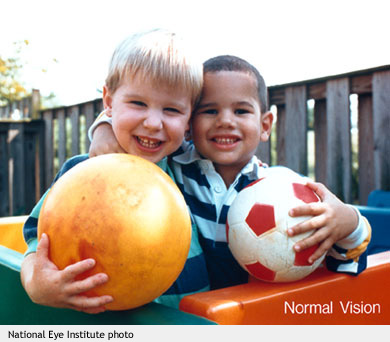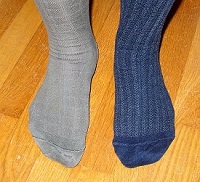What is a Cataract, and What Causes it?
An Introduction to Cataracts and Surgery
A cataract is when the normally transparent lens inside the eye progressively becomes cloudy, yellow, and hardens. A cataract is the leading cause of vision loss in the world. The World Health Organization (WHO) has estimated that cataracts cause 51% of blindness worldwide and that more than 20 million people are blind due to cataracts. However, 90% of these cases of blindness from cataracts is found in developing countries.
To talk about cataracts, it’s helpful to understand the parts of the eye, including the location and function of the lens, as shown in this diagram of the eye:
 Side View Diagram of the eye
Side View Diagram of the eye
The lens comprises transparent, flexible tissue and is located directly behind the iris and the pupil.
Like the lens in a camera, the lens in the eye helps to focus light and images onto the retina, which is the light-sensitive tissue that lines the inside surface of the eye.
Nerve cells in the retina convert incoming light into electrical impulses. These electrical impulses are carried by the optic nerve (which is like a television cable) to the brain, which finally interprets them as visual images.
At birth, the natural lens is clear and very flexible. The lens becomes more rounded to focus on near objects and thinner (or stretched) to focus on objects that are far away.
Over time, however, a few changes begin to occur in the lens, usually after age 40:
- First, the lens becomes less flexible, begins to harden, and loses its ability to become more curved. As a result, it becomes difficult to focus on near images (especially print) without the help of bifocals or reading glasses.
- Second, the lens gradually changes color, becoming yellow-brown, and is no longer clear or transparent. As a result, vision acquires a “brownish” tint, making it difficult to distinguish between certain colors, such as navy blue, brown, and black, or blue, green, and purple. This color change can also degrade the sharpness of a person’s vision.
How do cataracts affect everyday activities?
Cataracts cause an overall blurring of vision. People, objects, and colors look hazy, cloudy, and “washed out.” This lack of detail makes it difficult to tell time, read, watch television, see food on a plate, and walk safely indoors and outdoors. Surgery can usually be effective in removing cataracts. The National Eye Institute has provided the following photo:
Here is what a person with regular vision sees:

Here is what a person with cataracts sees:

Causes
There are various forms of cataracts; the most common cause of cataracts is age. Since the ancient Greeks and Romans, scientists have known that the lens matures with time. As we age, due to various reasons, including oxidative damage, the lens changes color, density, and clarity. In addition to the aging process, cataracts can also be caused by any of the following:
- Medication: Long-term use of corticosteroids such as prednisone has been correlated with cataract development;
- Physical injury or trauma: A blow to the eye, a cut or puncture, chemical burns, or electric shock can accelerate the cloudiness of the lens;
- Radiation: Long-term exposure to ultraviolet radiation from the sun (both UVA and UVB) can accelerate cataract formation. Radiation used to treat certain types of head and neck cancers can cause cataracts to develop as well;
- Poor nutrition: Diets that are deficient in antioxidants, such as beta-carotene (vitamin A), selenium, and vitamins C and E have been shown to increase the progression of cataracts;
- Smoking and second-hand smoke: Individuals who smoke 20 or more cigarettes a day have twice the risk of nonsmokers developing cataracts;
- Systemic diseases, such as diabetes and diabetic retinopathy;
- Eye diseases, such as uveitis, which is an inflammatory process that affects the interior of the eye;
- Cataracts can also be inherited or congenital (from birth).
Vision Changes That Affect Daily Functioning
The hardening, yellowing, and cloudiness of the lens caused by a cataract can result in the following vision changes that affect your daily functioning:
Blurred or hazy vision
- This lack of detail makes it difficult to tell time, read, watch television, see food on a plate, and walk safely indoors and outdoors since depth perception may also be affected. Some people with cataracts describe the effect as being similar to looking through a window that is hazy and streaked with dirt
- Difficulty reading regular print and need a brighter light to do more focused tasks. However, as this change occurs gradually, most people are unaware that their lighting requirements may have changed over time.
- Frequent changes in prescription eyeglasses or contact lenses.
- Development—or worsening—of nearsightedness
Reduced ability to tell certain colors apart
 Man wearing one brown and one blue sock
Man wearing one brown and one blue sock
- In order to see an object clearly against a background of the same color, for example, a brown chair against a dark rug, becomes more difficult and requires an increase in background contrast in order to make it stand out.
- This also affects depth perception, such as judging the height of a step or curb, or the depth of a bathtub.
- Reduced color perception can make it difficult to tell the brown and blue socks apart.
Problems with glare
- Especially bright sunlight and room lights. Although we need more light as we get older, too much light can also cause problems. Bright outdoor sunlight or reflected light from a hallway with highly polished floors can make it difficult to see clearly because too much light can also produce glare, which can interfere with seeing our surroundings clearly.
- People also tend to notice difficulty with night driving due to glare from oncoming headlights.
- Also, complain of seeing halos around lights, especially at night.
- Difficulty seeing at night.
- Seeing “halos” around lights, especially at night.
- Double vision (diplopia), or seeing a “ghost” image when using the affected eye. Double vision can also be a sign of a serious neurological condition and needs to be evaluated by a doctor.
By Tina D. Turner, M.D.,
Updated by Sefy Paulose, M.D., March, 2022
How Will My Child Function with Cataracts
You may learn your child has difficulty recognizing faces and facial expressions, accessing information from a distance, identifying small images or letters on paper, or traveling safely. If this is the case, your child may benefit from travel training from the mobility specialist, increased contrast of the environment, increased contrast of print by using a CCTV or screen-magnification software, and increased room and task lighting. Your child may also benefit from assistive technology to more easily write, read, use the computer, and access information and from techniques and additional accommodations to perform activities with limited vision.
Furthermore, your child may have discomfort and poorer vision in bright light as well as difficulty seeing in dimly lit environments. For daytime travel, recreation, or work, use sunglasses and hats. An infrared night scope may help with evening travel.
Resources for Families of Children with Cataracts